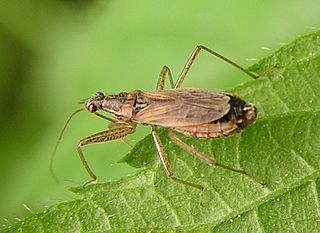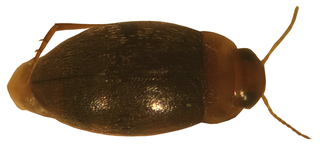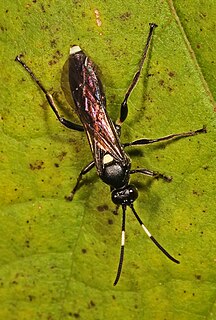
The insect family Nabidae contains the damsel bugs. There are over 500 species in 20 genera. They are soft-bodied, elongate, winged terrestrial predators. Many damsel bugs catch and hold prey with their forelegs, similar to mantids. They are considered helpful species in agriculture because of their predation on many types of crop pests.

Streptocarpus sect. Saintpaulia is a section within Streptocarpus subgenus Streptocarpella consisting of about ten species of herbaceous perennial flowering plants in the family Gesneriaceae, native to Tanzania and adjacent southeastern Kenya in eastern tropical Africa. The section was previously treated as a separate genus, Saintpaulia, but molecular phylogenetic studies showed that it was nested within the genus Streptocarpus.

Delphacidae is a family of planthoppers containing about 2000 species, distributed worldwide. Delphacids are separated from other "hoppers" by the prominent spur on the tibia of the hindleg.
Streptocarpus inconspicuus, synonym Saintpaulia inconspicua, is a species of Streptocarpus in the section Saintpaulia. It is a rare African violet, found in the Uluguru Mountains in Tanzania, East Africa. It was first formally described in 1958. It is classed as an endangered species by the IUCN Red List.

Uromyces is a genus of rust fungi in the family Pucciniaceae. The genus was described by Franz Unger in his 1833 work Die Exantheme der Pflanzen.
Mimulus inconspicuus is an uncommon species of monkeyflower known by the common name smallflower monkeyflower.
Drymaeus inconspicuus is a species of tropical air-breathing land snail, a pulmonate gastropod mollusk in the family Bulimulidae.

The Ropalomeridae are a family of acalyptrate flies.
Paramenexenus inconspicuus, is a species of phasmid or stick insect of the genus Paramenexenus. It is found in Sri Lanka.
Cubanopyllus is a monotypic genus of Caribbean ground spiders containing the single species, Cubanopyllus inconspicuus. It was first described by G. Alayón G. & Norman I. Platnick in 1993, and has only been found in Cuba.

Bidessonotus inconspicuus is a species of predaceous diving beetles in the family Dytiscidae. It is found in North America.

Pedilus is a genus of fire-colored beetles in the family Pyrochroidae. There are at least 20 described species in Pedilus.

Vulgichneumon is a genus of ichneumon wasps in the family Ichneumonidae. There are at least 30 described species in Vulgichneumon.
Phyllotrox is a genus of true weevils in the beetle family Curculionidae. There are at least 60 described species in Phyllotrox.
Melanoplus inconspicuus, the inconspicuous spur-throat grasshopper, is a species of spur-throated grasshopper in the family Acrididae. It is found in North America.

Chaoborus punctipennis is a species of phantom midges.
Villasitocoris is a genus of leaf-footed bugs in the family Coreidae. There is one described species in Villasitocoris, V. inconspicuus.

Criomorphus is a genus of delphacid planthoppers in the family Delphacidae. There are about 13 described species in Criomorphus.
Tominotus is a genus of burrowing bugs in the family Cydnidae. There are about 11 described species in Tominotus.
Animal Ethics is a nonprofit organization formed to promote discussion and debate around issues in animal ethics and to provide information and resources for animal advocates. They also do outreach work in several countries on the issue of speciesism. Their aim is to create a world where moral consideration is extended to all sentient beings. The organization's website covers topics such as speciesism, sentience, veganism and wild animal suffering and has content translated into several languages.









